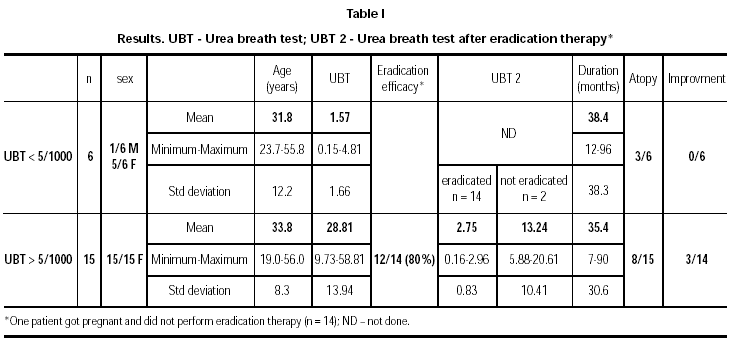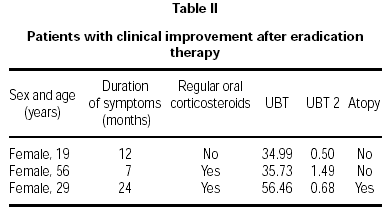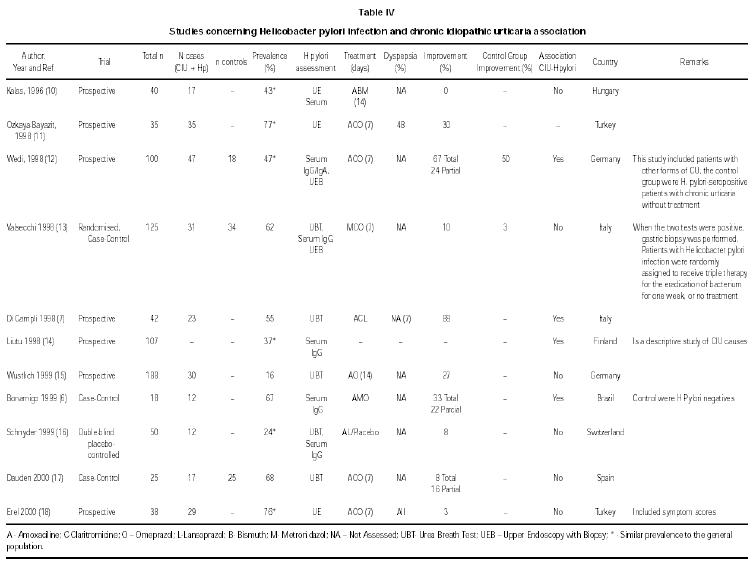INTRODUCTION
Chronic urticaria is one of the most frequent skin diseases in allergy practice. However it's causes remain unknown in the vast majority of cases. Urticaria is a common disease with prevalence ranging between 15 and 25 %1, but when chronic is a seriously disabling condition, with social isolation and mood changes causing a significant degree of dysfunction and quality of life impairment to many patients. Its cause, however, can only be found in less than 10 % of patients1.
Chronic infections and parasitic infestations have long been suggested to be an important causal factor for chronic urticaria, but this has never been consistently proven. It has been approximately 15 years since Helicobacter pylori (Hp) was first isolated from the human stomach2. Helicobacter pylori, a microaerophilic gram-negative bacteria, is associated with duodenal and gastric ulcer, gastric cancer, and atrophic gastritis and is a ubiquitous infection in the adult population3. Its prevalence is directly proportional to age and inversely correlated with socio-economic status in developing countries, in which prevalence rates reach 80 %4 The risk of infection is increased substantially by crowded living conditions and by poor sanitation.
There is increasing evidence for systemic effects of gastric Hp infection, which may be involved in extragastrointestinal disorders such as vascular, autoimmune and skin diseases. A possible relationship between chronic idiopathic urticaria (CIU) and Hp infection has been suggested in preliminary studies, in which antibiotic eradication of Hp lead to regression of urticaria in up 100 % of cases5-7.
The aim of this open prospective study is to determine the prevalence of Hp infection in a series of patients with CIU, and evaluate the effectiveness of eradication of Hp on the skin disease.
PATIENTS AND METHODS
We included patients attending our outpatient Immunoallergology clinic between September 1999 and February 2001, with daily, or almost daily, occurrence of urticaria for at lest six weeks. Wheals should last longer than 1 hour and less than 24 hours and not cause residual pigmentation; they should not be related to local pressure areas (waistband, palm, soles) or cold stimulus. We only included previously healthy subjects, without known systemic infection or immune disease. The study was conducted in a University Hospital in the city of Oporto that assists people from urban and rural areas of the north of Portugal.
For each patient a detailed symptom history and exhaustive physical examination were performed. Gastrointestinal symptoms, urticaria exacerbation's factors, focal infections, drug or food additives hypersensitive were assessed.
Physical urticaria like symptomatic dermographism, delayed pressure urticaria, cold urticaria, aquagenic urticaria, solar urticaria, and cholinergic urticaria were excluded. We also excluded those with a history of food allergy and those who had received antibiotics or bismuth containing drugs during the month prior to inclusion or that that have been treated with proton pump inhibitors during the week prior to inclusion. Patients currently participating in any clinical trial of any kind, with concomitant diseases, conditions or treatments that interfere with the evaluation of the treatment effect, with childbearing potential without adequate contraception or pregnancy or breast-feeding, and the ones that have been previously enrolled in an Hp eradication study were also excluded.
All patients were informed about the study and agreed to participate. The study was in accordance with the Declaration of Helsinki of the World Medical Association and was approved by the Hospital Medical Ethics Committee.
Each patient was studied according a protocol, that included collecting blood samples for erythrocyte sedimentation rate, differential blood count, complete blood biochemistry, urinalysis, protein electrophoresis, thyroid function (free T3, free T4, Thyroid stimulating hormone), faecal examinations for ova or parasites, autoantibodies, circulating immunocomplexes, total IgE, and complement studies (C1 inhibitor, C3, C4). During the study all the patients kept their standard treatment of antihistamines and/or corticosteroids.
Determination of Helicobacter pylori infection
Hp infection was assessed by 13C urea breath test (UBT). The breath test for Hp is a non-invasive diagnostic procedure using analysis of breath samples to determine the presence of Hp. The test is based on the presence of urease produced by the bacteria. After at least 8 hours of fasting, the patient was given 20 ml 0.1 N citric acid containing 100 mg of labelled Carbon 13C urea. The test is performed by the differential detection of labelled Carbon 13C collected in baseline breath samples and test breath samples after ingestion.
The system utilises a Gas Isotope Ratio Mass Spectrometer- Unicam® for the measurement of the ratio of 13CO2 to 12CO2 in breath samples. Results were expressed as change per thousand. A positive test was defined as an average increase in the ratio of 5/1000 over baseline.
Eradication therapy and follow-up
Amoxicillin (1g per os twice a day), clarithromycin (500 mg per os twice a day), and omeprazole (20 mg per os twice a day) were given to infected patients for seven days. With this eradication therapy, Gomollon et al had eradication rates superior to 90 % in a Spanish population8. All patients were informed to notify the investigators about discontinuation of the therapy and the reasons to do so. Compliance with treatment was assessed by questionnaire. Minimum accepted intake of total doses was 75 %. The results of therapy were assessed by urea breath test six weeks after therapy Hp eradication was defined as average increase of 13CO2 less than 5/1000.
The clinical evaluation and follow-up were for 6 months after eradication. Recurrence of symptoms was defined as the reappearance of urticaria symptoms. Cases with partial or no remission were considered as cases with persisting urticaria.
Statistical analysis
Statistical significance of data was assessed using SPSS v 10.0 software. To study the association between CIU and the result of UBT we use the chi-square test. To study the means of numeric variables between groups with positive and negative UBT Student's t-test was applied.
RESULTS
Twenty females and one male patients, over 18 years with clinical and laboratory evidences of CIU have been studied. Mean ages were 33 years (minimum 19 years, maximum 55 years), with mean duration of symptoms of 36 months (7 months up to 96 months). Laboratory parameters concerning erythrocyte sedimentation rate, differential blood count, complete blood biochemistry, urinalysis, protein electrophoresis, thyroid function (T3, T4, TSH), faecal examinations for ova or parasites, autoantibodys, circulating immunocomplexes, and complement study didn't show any abnormal features, as according to our inclusion criteria. Total IgE ranged between 19 kU/l and 1657 kU/l (median of 276 kU/L).
None of the patients reported gastrointestinal complaints. All were on daily antihistamines and only two were also on regular oral corticosteroids.
Fifteen patients had positive UBT, that is a prevalence of 71.4 %, and the mean variation of incremental increase in respiratory 13CO2 was 28.81 (minimum 9.73 and maximum 58.81). One patient got pregnant and was excluded. There were no differences in mean duration of symptoms (38.4 vs. 35.4 months) and mean ages (31.8 vs. 33.8 years) between groups with negative and positive UBT respectively.
Helicobacter pylori eradication rate was of 80 % (12/14) for one-week triple therapy with amoxaciline, clarithromycin and omeprazol. Mean variation of increase in the second UBT was 2.75 (minimum 0.16 and maximum 2.96). In (table I) we summarize results for patients with negative and positive UBT.
Three patients (table II) had clinical improvement with total resolution of urticaria starting immediately after eradication therapy, being able to completely withdrawn antihistamine and corticosteroids therapy without complaints. In relation to the rest of the patients, these three had smaller duration of urticaria disease (14.3 vs. 43.7 months; p = 0.038) and greater titters in the UBT results (42.39 vs. 25.81; p = 0.073) (table III). There was no difference in the mean ages (35 vs. 34 years).
DISCUSSION
Chronic urticaria has been described to be triggered by several disease states ranging from allergic reactions to food or additives, parasitoses, microbial infections and autoimmune mechanisms. With the discovery of Hp, probably the worldwide most common chronic bacterial infection in humans, the possibility of this bacteria as a focus for chronic urticaria become a hypothesis. The initial studies to check for this association showed high prevalence of Hp infection in patients suffering from CIU and high remission rates of urticaria after eradication therapy. However, next studies, with broader samples, different design and methods for assessing Hp infection failed to show any significant correlation between them. Neither has become proved that Hp prevalence is higher in CIU patients. Such different results can be explained not only by different assessment tools but also by differences in the antigenicity or biological activity of the bacteria in different areas, with different socio-economic and genetical patterns of the host population. In (table IV) we present the principal studies conducted so far to study a possible link between Hp and CIU.
In our findings we failed to shown a significative association between Hp infection and CIU. However, we cannot exclude that there are some unexplored factors that could affect individual susceptibility to the bacteria. In such cases, Hp infection could be involved in the pathogenesis of urticaria. Local inflammatory response to Hp infection is dependent not only on the virulence of the organism but also on host and environmental factors13,14 The possibility that different strains of Hp are involved, that is, strains with different genetic profiles, which may elicit more or less pathogenic responses has already been suggested19. Host factors like the presence in gastric mucosa of Lewis b antigen20, a receptor for Hp, could be an individual susceptibility factor for infection and indirectly for development of other pathologies related to the bacteria. An interplay among these variables leads to the release of inflammatory mediators that impair host defences and alter acid secretion. However this process remains an enigma, being tempting to speculate that structural components like adhesins or products of Hp such urease, protease, phospholipase or cytotoxines can be released and be responsable for complement activation.
One of the issues, which were not addressed in previous studies, was the absolute bacteria count and its relation with urticaria development in susceptible individuals. Several reports have already showed that UBT results correlates well with the quantitative assessment of the extent of Hp colonization in the stomach21 When we compare the patients with clinical improvement with the others we found higher levels of incremental increase in respiratory 13CO2 in the UBT, reflecting a larger quantity of Hp colonization. These findings suggest that the amount of bacteria could be in some patients a factor related to urticaria.
Although our results and the review of literature failed to clearly demonstrate a relationship between Hp infection and CIU, our work raises the question of the importance of the degree of Helicobacter pylori colonization to induce urticaria symptoms.












